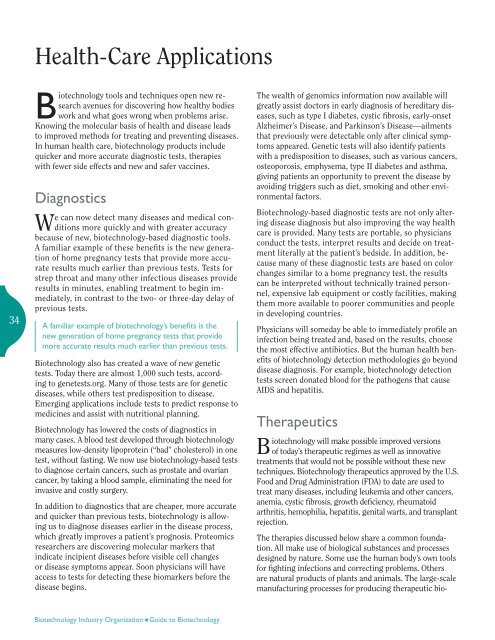Introduction Guide to Biotechnology - Biomolecular Engineering Lab
Introduction Guide to Biotechnology - Biomolecular Engineering Lab
Introduction Guide to Biotechnology - Biomolecular Engineering Lab
You also want an ePaper? Increase the reach of your titles
YUMPU automatically turns print PDFs into web optimized ePapers that Google loves.
Health-Care Applications<br />
34<br />
<strong>Biotechnology</strong> <strong>to</strong>ols and techniques open new research<br />
avenues for discovering how healthy bodies<br />
work and what goes wrong when problems arise.<br />
Knowing the molecular basis of health and disease leads<br />
<strong>to</strong> improved methods for treating and preventing diseases.<br />
In human health care, biotechnology products include<br />
quicker and more accurate diagnostic tests, therapies<br />
with fewer side effects and new and safer vaccines.<br />
Diagnostics<br />
We can now detect many diseases and medical conditions<br />
more quickly and with greater accuracy<br />
because of new, biotechnology-based diagnostic <strong>to</strong>ols.<br />
A familiar example of these benefits is the new generation<br />
of home pregnancy tests that provide more accurate<br />
results much earlier than previous tests. Tests for<br />
strep throat and many other infectious diseases provide<br />
results in minutes, enabling treatment <strong>to</strong> begin immediately,<br />
in contrast <strong>to</strong> the two- or three-day delay of<br />
previous tests.<br />
A familiar example of biotechnology’s benefits is the<br />
new generation of home pregnancy tests that provide<br />
more accurate results much earlier than previous tests.<br />
<strong>Biotechnology</strong> also has created a wave of new genetic<br />
tests. Today there are almost 1,000 such tests, according<br />
<strong>to</strong> genetests.org. Many of those tests are for genetic<br />
diseases, while others test predisposition <strong>to</strong> disease.<br />
Emerging applications include tests <strong>to</strong> predict response <strong>to</strong><br />
medicines and assist with nutritional planning.<br />
<strong>Biotechnology</strong> has lowered the costs of diagnostics in<br />
many cases. A blood test developed through biotechnology<br />
measures low-density lipoprotein (“bad” cholesterol) in one<br />
test, without fasting. We now use biotechnology-based tests<br />
<strong>to</strong> diagnose certain cancers, such as prostate and ovarian<br />
cancer, by taking a blood sample, eliminating the need for<br />
invasive and costly surgery.<br />
In addition <strong>to</strong> diagnostics that are cheaper, more accurate<br />
and quicker than previous tests, biotechnology is allowing<br />
us <strong>to</strong> diagnose diseases earlier in the disease process,<br />
which greatly improves a patient’s prognosis. Proteomics<br />
researchers are discovering molecular markers that<br />
indicate incipient diseases before visible cell changes<br />
or disease symp<strong>to</strong>ms appear. Soon physicians will have<br />
access <strong>to</strong> tests for detecting these biomarkers before the<br />
disease begins.<br />
The wealth of genomics information now available will<br />
greatly assist doc<strong>to</strong>rs in early diagnosis of hereditary diseases,<br />
such as type I diabetes, cystic fibrosis, early-onset<br />
Alzheimer’s Disease, and Parkinson’s Disease—ailments<br />
that previously were detectable only after clinical symp<strong>to</strong>ms<br />
appeared. Genetic tests will also identify patients<br />
with a predisposition <strong>to</strong> diseases, such as various cancers,<br />
osteoporosis, emphysema, type II diabetes and asthma,<br />
giving patients an opportunity <strong>to</strong> prevent the disease by<br />
avoiding triggers such as diet, smoking and other environmental<br />
fac<strong>to</strong>rs.<br />
<strong>Biotechnology</strong>-based diagnostic tests are not only altering<br />
disease diagnosis but also improving the way health<br />
care is provided. Many tests are portable, so physicians<br />
conduct the tests, interpret results and decide on treatment<br />
literally at the patient’s bedside. In addition, because<br />
many of these diagnostic tests are based on color<br />
changes similar <strong>to</strong> a home pregnancy test, the results<br />
can be interpreted without technically trained personnel,<br />
expensive lab equipment or costly facilities, making<br />
them more available <strong>to</strong> poorer communities and people<br />
in developing countries.<br />
Physicians will someday be able <strong>to</strong> immediately profile an<br />
infection being treated and, based on the results, choose<br />
the most effective antibiotics. But the human health benefits<br />
of biotechnology detection methodologies go beyond<br />
disease diagnosis. For example, biotechnology detection<br />
tests screen donated blood for the pathogens that cause<br />
AIDS and hepatitis.<br />
Therapeutics<br />
<strong>Biotechnology</strong> will make possible improved versions<br />
of <strong>to</strong>day’s therapeutic regimes as well as innovative<br />
treatments that would not be possible without these new<br />
techniques. <strong>Biotechnology</strong> therapeutics approved by the U.S.<br />
Food and Drug Administration (FDA) <strong>to</strong> date are used <strong>to</strong><br />
treat many diseases, including leukemia and other cancers,<br />
anemia, cystic fibrosis, growth deficiency, rheuma<strong>to</strong>id<br />
arthritis, hemophilia, hepatitis, genital warts, and transplant<br />
rejection.<br />
The therapies discussed below share a common foundation.<br />
All make use of biological substances and processes<br />
designed by nature. Some use the human body’s own <strong>to</strong>ols<br />
for fighting infections and correcting problems. Others<br />
are natural products of plants and animals. The large-scale<br />
manufacturing processes for producing therapeutic bio-<br />
<strong>Biotechnology</strong> Industry Organization n <strong>Guide</strong> <strong>to</strong> <strong>Biotechnology</strong>
















